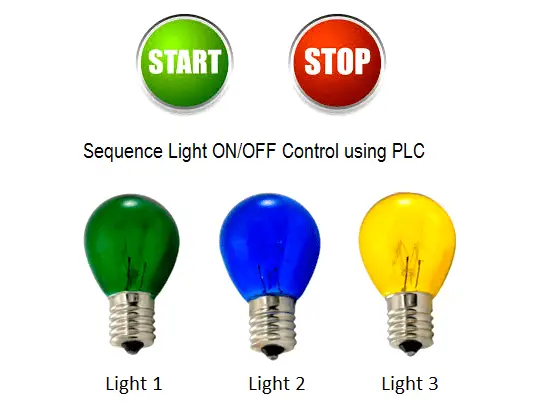

- #Light sequencing ladder logic program examples how to
- #Light sequencing ladder logic program examples full
Timer T completes this same cycle, starting timer T upon completion of its timer and resetting, and timer T re-starting the cycle at timer T The final three rungs are simply telling the PLC to turn on the lights when their corresponding timer is timing. The PLC reads from the top rung down, and without a command to start the program, which is generally achieved by actuating an input, the timer will not start.
#Light sequencing ladder logic program examples how to
As a technician, understanding what logic someone used when designing their program is important to understand how to troubleshoot the program when issues arise.

The first timer is the time duration that the red light will remain on, the second timer corresponds to the yellow light and the third to the green light.įor this example, time increments of 10 seconds, 2 seconds and 8 seconds were used. Their menus can be opened by double-clicking the name in the drop-down menu on the left side of the screen. O addresses correspond to outputs, B addresses to Binary, and T addresses to Timer. Timers and Binary are internal bits that are counted within the program and do not have any external connections.Īssigning the addresses can be done with the same drag and drop method. Outputs are connected to items that need to be turned on or off, such as relays, motor starting contacts, or lights. They can range from an ultrasonic sensor to a touch sensor to a push button. Inputs are connected to switches, which can be anything that can be switched between an on or off state when the desired outcome occurs from the switch being actuated. To begin, there are many ways to go about programming any given rung of a PLC to achieve the same result, some are more efficient for the processor, others are easier to troubleshoot when issues arise down the road. The Binary and Output bit addresses for this program are all in the top line of the table, starting at 0 on the right side. DN will be enabled when the timer reaches its preset time. In the timer table, TT refers to "Timer Timing," meaning the bit will be enabled when the timer is timing. The bottom three pictures show the Timer, Output and Binary tables, and where they can be located in the menu on the left side of the screen. The second command set, directly below the first picture is the timer set, the only command used from this set in this program will be the "TON" or Timer On. The top picture shows the basic commands, the only ones used from this set are the first five. RSLogix uses "Drag and Drop" for placement of its commands and addresses, meaning to insert the command or address, simply click and drag it from the menu to the desired location, then drop it. Ems delivery trackingĪll ports are clearly marked on the PLC.
#Light sequencing ladder logic program examples full
For this application, the full wiring shown in the picture above is not required, only the wiring described below.

CAUTION: Never work on a live circuit, the AC line of the power is connected directly to the wall outlet and V, enough to kill a human or cause severe electrical burns including damage to internal organs.Īlways unplug the circuit, disable the circuit breaker and verify that the circuit has been de-energized. Did you use this instructable in your classroom? Add a Teacher Note to share how you incorporated it into your lesson. They will also show how to program the PLC to output the correct lights at the correct intervals. These steps will show how to connect the PLC to the inputs and outputs to begin programming. The following guide will show how to create a functioning stop light with a PLC. PLCs are used in everything we encounter on a daily basis.


 0 kommentar(er)
0 kommentar(er)
